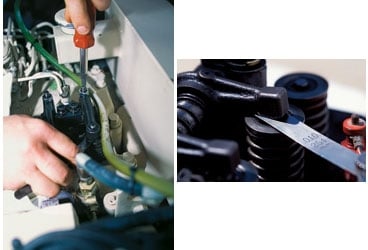
rocker arm set screw 368
Diesel engines are legendary for their reliability, durability, and fuel economy. There’s a price to be paid for these attributes, though, and that’s proper maintenance of key components. And one of those maintenance regimens-adjusting the valves-will, if deferred, quickly negate all of a diesel engine’s virtues.
Valve adjustment is critically important, yet it’s also among the most frequently overlooked or forgotten tasks because to adjust them, you have to delve into the heart of your engine.
Intake and exhaust valves are found within an engine’s cylinder head-that 4- or 5-inch-thick hunk of iron that’s bolted to the top of the block-and under the valve cover, which is made from lighter metal and protects the many working parts involved. Valves, which are vaguely shaped like mushrooms, are opened and closed through a combination of action from the camshaft and the valve springs. The former opens a valve either by lifting a push-rod and rocker arm that depresses the valves in a set order or, in the case of an overhead cam, by acting directly on the valves. Springs on the valve stems close them again.
When the engine’s running, the valves move at eye-blurring speed in a delicate and precise manner. However, if the balance and precision of one of the moving parts associated with a valve train-the lifters, pushrods, springs, rocker arms, and the valves themselves-is affected, then chaos quickly ensues. The opening and closing of the valves allows fresh air to enter the cylinder and exhaust gasses to exit once combustion is complete. If the clearance between the valve stem and the rocker isn’t within the engine manufacturer’s tolerance, the valve will either open too far or not far enough; it may also stay open too long or close too soon. Any of these scenarios can cause decreased power, hard starting, poor fuel economy, and excess smoke.
Valve adjustment should occur at the engine manufacturer’s specified intervals, perhaps every 250, 400, or 500 hours; for precise figures, consult the owner’s manual for your engine. Adjustment requires a clear understanding of the procedure-experience helps, but it’s not necessary, provided that you follow the service-manual instructions-as well as the ability to use feeler gauges and a wrench.
While each engine is different, here’s a basic walk-through of the job. Following the sequence specified in your engine manual, use the starter, a breaker bar, or a crank to rotate the engine-always while it’s turned off-until a specified valve is closed and its associated piston has traveled to the top of the cylinder.
The correct clearance between a valve and the rocker arm or cam varies by engine and sometimes between intake and exhaust valves. In general, it’s usually in the range of .010 to .012 inch. If the clearance isn’t correct, take your wrench and loosen the locking nut on the rocker arm, then use a screwdriver to obtain the correct amount of space by turning the adjustment screw. When set properly, the feeler gauge should move smoothly into the opening between the valve stem and rocker, but there shouldn’t be any play there. When the clearance is correct, use your screwdriver to hold the set-screw steady, then tighten the locking nut. Recheck the clearance, then proceed to the next valve, rotating the engine accordingly.
Remember, a valve must be fully closed and in its seat before it can be adjusted.
Valve adjustment usually takes no more than a few hours, and when you’re done, remember to replace the gasket on the valve cover. The value of keeping these little workhorses in proper adjustment is incalculable. If it’s carried out at the manufacturer’s specified intervals, it’ll ensure economical and reliable engine operation for many more hours.
Steve D’Antonio is a regular Cruising World contributor who offers services for vessel owners, boatbuilders, and others in the marine industry through Steve D’Antonio Marine Consulting (www.steved
marineconsulting.com).








